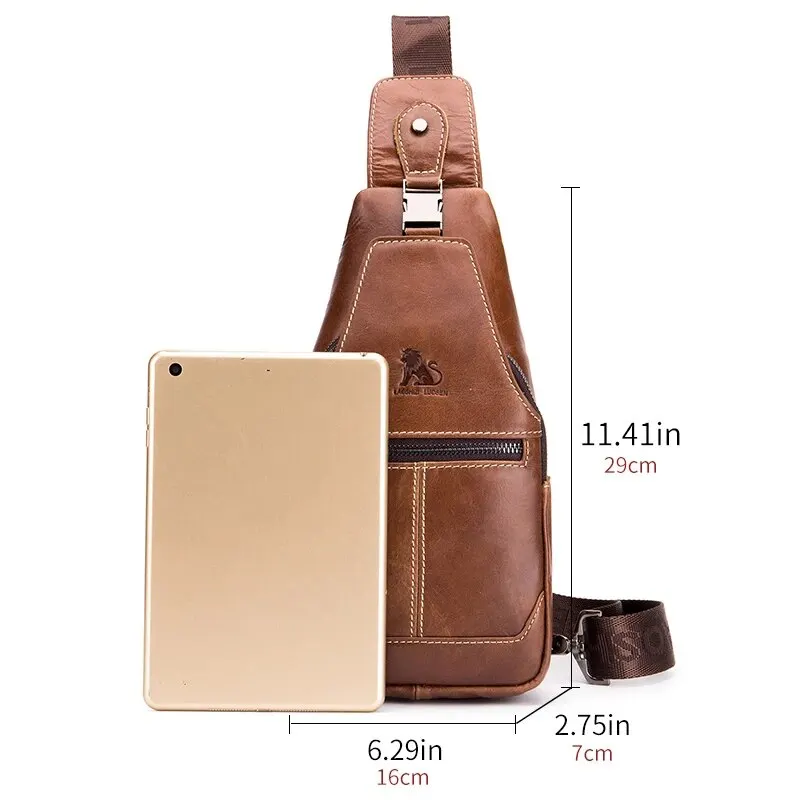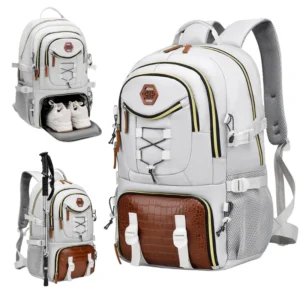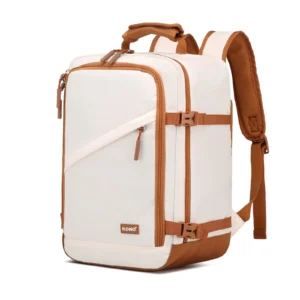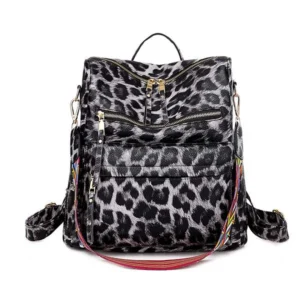The Science of Balanced Backpack Loading: Why It Matters
Properly balancing your backpack’s weight is much more than a packing preference—it’s a science that directly impacts your outdoor experience. When weight is distributed evenly throughout your pack, you create a stable system that works with your body’s natural movement rather than against it.
The concept of balanced loading centers around aligning your backpack’s center of gravity with your own. This alignment helps maintain your natural posture and walking gait, allowing for more efficient movement on the trail. Physics principles tell us that a load closest to your center of gravity requires less energy to move, which translates directly to less fatigue during your journey.
Evenly packed backpacks offer several key benefits:
- Reduced muscle strain – Properly distributed weight minimizes strain on your shoulders, neck, and lower back
- Improved stability – A balanced pack prevents uncomfortable shifting and swaying as you move
- Better energy efficiency – Less energy wasted on compensating for an unbalanced load means more energy for enjoying your adventure
- Enhanced breathing – Proper weight distribution prevents compression of your diaphragm, allowing for fuller breathing
- Decreased risk of injury – Even loading reduces the chance of falls and strains caused by sudden shifts in weight
Maintaining your backpack properly through leather conditioning and waterproofing helps ensure your pack will continue to carry your load comfortably for years to come. A well-maintained pack with intact padding and support systems is essential for maintaining proper weight distribution.
Strategic Backpack Zones: The Foundation of Even Weight Distribution
Understanding the different zones of your backpack is critical for achieving balanced weight distribution. Modern backpacks are designed with specific compartments that serve distinct purposes in creating a stable, comfortable load. Each zone plays a vital role in maintaining balance while keeping items organized and accessible when needed.
Bottom Zone (Sleeping & Overnight Items)
The bottom zone of your backpack serves as the foundation for your packing strategy. This area is ideal for bulky, lightweight items that you won’t need until making camp. By placing these items at the bottom, you create a soft, cushioning base that helps stabilize the rest of your pack’s contents.
Ideal items for the bottom zone include:
– Sleeping bag (often in a compression sack)
– Sleep clothes and extra layers
– Tent body (separate from poles)
– Inflatable sleeping pad
These lightweight but voluminous items help create a stable base while maximizing the use of the typically tapered bottom section of most backpacks.
Core/Middle Zone (Heavy & Dense Items)
The core or middle zone is the powerhouse of your pack—it’s where the heaviest items should be concentrated. Placing dense, heavy gear in this section keeps the weight close to your back and centered between your shoulder blades. This positioning aligns the pack’s center of gravity with your own, creating a more natural carrying experience.
Ideal items for the core zone include:
– Food bag (typically 1-2 pounds per day)
– Cooking gear and stove
– Water reservoir or heavier water containers
– Bear canister (if required)
– Denser clothing items
Our large leather backpack collection offers excellent organization features that help maintain proper weight distribution in this critical zone.
Top Zone (Access & Essentials)
The top zone of your backpack should be reserved for items you’ll need frequent access to during your hike. This strategic placement prevents you from having to dig through your entire pack when you need something quickly.
Ideal items for the top zone include:
– Rain jacket or weather protection
– First aid kit
– Lunch and snacks for the day
– Navigation tools and maps
– Headlamp or flashlight
– Light insulating layer
Remember that removing items from the top of your pack throughout the day will change your weight distribution, so try to balance items that will be consumed or used.
External Pockets & Attachment Points
External storage options provide quick access to essentials without disrupting your pack’s internal organization. However, these areas should be used strategically to avoid creating an unbalanced load.
Effective use of external storage includes:
– Water bottles in side pockets (balanced left and right)
– Small snacks in hip belt pockets
– Map or guide in outer pocket
– Trekking poles on attachment points (when not in use)
– Light rain gear in top lid pocket
Limit the weight in external pockets to no more than 2-3 pounds total to prevent your pack from becoming unbalanced or causing unnecessary swinging during movement.
Core Principles of Even Weight Distribution
To truly master backpack weight distribution, you need to understand the three dimensions of balance that affect your comfort and stability. These principles work together to create a pack that feels like a natural extension of your body rather than a burdensome load.
Vertical Alignment: Working With Your Center of Gravity
Proper vertical alignment places the heaviest items at a specific height in your pack—typically between your shoulder blades or slightly below. This positioning keeps the weight centered on your strongest muscles and aligned with your body’s own center of gravity.
For most hikers, the sweet spot for heavy items is 2-4 inches above the hipbelt, roughly at mid-back level. This placement allows your core muscles to support the load efficiently while maintaining natural posture. On flatter terrain, you might place heavy items slightly higher, while technical terrain might benefit from a slightly lower placement for increased stability.
When packing for air travel, similar vertical alignment principles apply to how you pack a leather carry-on backpack, ensuring comfort even in transit.
Lateral Balance: The Side-to-Side Equation
Equal weight distribution from left to right is crucial for preventing muscle strain and maintaining a comfortable hiking gait. Lateral imbalance can cause your pack to pull to one side, leading to shoulder and hip pain as your body compensates for the uneven load.
To check for lateral balance:
1. Stand with your packed backpack in front of a mirror
2. See if the pack leans to one side
3. Notice if one shoulder strap carries more tension than the other
A common technique for maintaining lateral balance is positioning water bottles of equal weight on opposite sides of your pack. Similarly, when packing clothing or gear, try to distribute comparable weights evenly across both sides of your pack’s interior.
Front-to-Back Stability: Preventing the Backward Pull
The distance between your pack and your back significantly impacts your stability and energy efficiency. When a pack pulls away from your body (too much weight far from your back), it creates leverage that strains your shoulders and lower back.
For optimal front-to-back stability:
– Keep the pack’s profile relatively flat against your back
– Use compression straps to bring the load closer to your body
– Avoid hanging heavy items on the outside of the pack
– Aim for a maximum pack depth of 2-3 inches from your back
Proper front-to-back balance prevents the uncomfortable “backward pull” that forces you to lean forward to compensate, leading to poor posture and increased fatigue.
Step-by-Step Packing Method for Perfect Balance
Follow this methodical approach to achieve optimal weight distribution in your backpack. This process takes approximately 15-30 minutes but saves hours of discomfort on the trail.
Step 1: Pre-Packing Organization
Before loading anything into your backpack, organize all your gear into categorical piles:
– Heavy items (food, cooking gear, water)
– Medium-weight items (clothes, some tools)
– Lightweight but bulky items (sleeping bag, puffy jacket)
– Frequently accessed items (rain gear, snacks, navigation)
Consider waterproofing needs at this stage, placing sensitive items in waterproof bags or containers. This organization makes the actual packing process much more efficient and helps you visualize your weight distribution before loading.
For travel-specific scenarios, our carry-on leather backpack collection offers excellent organization features that complement this pre-packing process.
Step 2: Bottom Zone Loading Technique
Begin packing by placing your sleeping bag at the very bottom of your pack. If your sleeping bag has a compression sack, compress it fully before placing it in the pack. Next, add other nighttime items like sleep clothes or a sleeping pad.
Key techniques for bottom zone packing:
– Use a stuff sack or compression sack for the sleeping bag
– Fill side gaps with soft items like clothing
– Consider using a pack liner or dry bag in wet environments
– Press items down firmly to create a solid foundation
The goal is to create a stable, compressed base that supports the heavier items that will sit above.
Step 3: Core Zone Heavy Item Placement
Position your heaviest items (food bag, cooking gear, etc.) in the center of the pack, directly against your back panel. Place these items at approximately mid-back height, which typically aligns with the area between your shoulder blades.
For optimal core zone packing:
– Center heavy items along your spine for balanced weight
– Keep dense items within 2-3 inches of your back panel
– Balance similar-weight items side by side
– Position your water reservoir against the back panel (if using one)
This placement creates a stable core that sits close to your center of gravity and provides the foundation for your pack’s balance.
Step 4: Middle and Upper Core Zone Filling
Surround your heavy core items with medium-weight gear like clothing layers, food for later days, or smaller equipment. This creates a solid, non-shifting center that maintains the pack’s stability.
Effective middle zone techniques include:
– Use clothing or soft items to fill empty spaces around heavy gear
– Distribute weight evenly from left to right
– Compress items as you pack to eliminate shifting
– Create a solid block of gear with minimal internal movement
Think of this step as creating a stable “shell” around your heaviest items.
Step 5: Top Zone Organization
In the top section of your pack, arrange items you’ll need frequent access to during the day. Place the most frequently needed items at the very top for easiest access.
Top zone packing tips:
– Place rain gear at the very top if weather is a concern
– Organize items by frequency of use (most frequent = most accessible)
– Keep a balance between left and right sides
– Avoid overloading this zone with heavy items
Remember that items in this zone should generally be lighter to maintain your pack’s vertical balance.
Step 6: External Attachment and Final Adjustments
Use external pockets and attachment points strategically for items you need quick access to. After loading all pockets, tighten all compression straps to secure your load and bring it closer to your body.
Final adjustment tips:
– Balance water bottles equally on both sides
– Attach trekking poles symmetrically when not in use
– Keep total external weight under 2-3 pounds if possible
– Tighten compression straps in a top-to-bottom sequence
Once packed, lift your backpack and notice how it feels. Make minor adjustments as needed to achieve optimal balance.
Advanced Weight Distribution Techniques for Experienced Backpackers
As you gain experience with backpacking, you can implement more sophisticated techniques to fine-tune your pack’s balance and adapt to changing conditions on the trail.
Strategic Compression Systems: Beyond Basic Straps
Advanced backpackers understand that compression is about more than just tightening straps—it’s about creating a solid, unified load that moves with you rather than against you.
Advanced compression techniques:
– Create zones of different compression (tighter at bottom, moderate in core)
– Use clothing strategically as internal compression around odd-shaped items
– Employ the “burrito method” for sleeping bags (rolling tightly with air squeezed out)
– Cross-link external compression straps for maximum stability
Our roll-top leather backpack designs offer excellent compression options that help maintain a solid, well-distributed load.
Carry On Leather Backpack, Roll Top Leather Backpack
Price range: $77.76 through $96.48 Select options This product has multiple variants. The options may be chosen on the product page17 Inch Leather Laptop Backpack, Men's Leather Travel Backpack, Men's Leather Work Backpack
Price range: $106.28 through $143.88 Select options This product has multiple variants. The options may be chosen on the product page15 Inch Leather Laptop Backpack, Carry On Leather Backpack
Price range: $136.84 through $139.88 Select options This product has multiple variants. The options may be chosen on the product pageLarge Leather Backpack, Women's Leather Backpack
Price range: $97.12 through $97.96 Select options This product has multiple variants. The options may be chosen on the product page- $123.08 Select options This product has multiple variants. The options may be chosen on the product page
Women's Leather Backpack, Women's Leather Travel Backpack
$117.64 Select options This product has multiple variants. The options may be chosen on the product page
Dynamic Weight Redistribution: Adapting on the Trail
Your backpack’s weight distribution isn’t static—it changes as you consume food, drink water, and use supplies. Experienced backpackers actively manage these changes to maintain optimal balance throughout their journey.
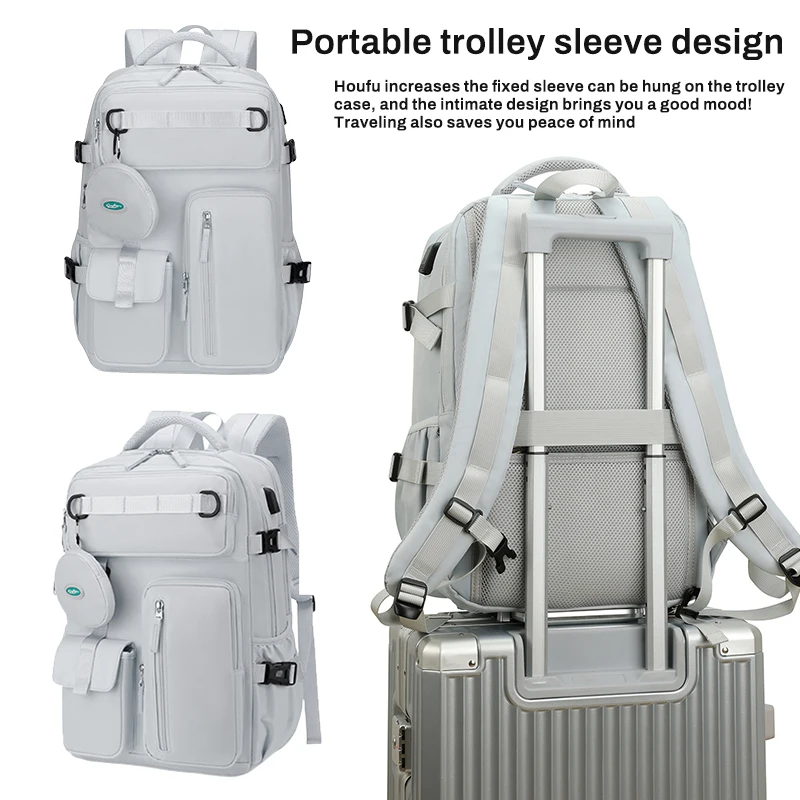
Dynamic redistribution strategies:
– After consuming significant water, rebalance remaining water bottles
– As food is consumed, consider moving the food bag slightly higher
– For multi-day trips, pack food for later days deeper in the core
– In changing terrain, adjust load height (lower for technical terrain, higher for flat hiking)
This proactive approach keeps your pack comfortable as its contents change throughout your journey.
Specialized Equipment Integration
Certain activities require specialized gear that can challenge traditional packing approaches. Understanding how to integrate these items while maintaining balance is a mark of backpacking expertise.
Strategies for special equipment:
– Bear canisters: Place horizontally in the middle zone, centered against your back
– Climbing rope: Coil and place vertically in the core zone
– Ice axe: Attach externally but counterbalance with similar weight on the opposite side
– Camera gear: Keep protected but accessible in the upper core section
When the weight or shape of specialized equipment disrupts normal balance, make compensatory adjustments elsewhere in your pack.
The Crucial Relationship Between Pack Fit and Weight Distribution
Even the most perfectly packed backpack will feel uncomfortable if it doesn’t fit your body correctly. Fit and weight distribution work together to create a comfortable carrying experience.
Torso Length and Hipbelt Position
Your backpack’s torso measurement should match your own torso length (typically measured from the C7 vertebra to the iliac crest). When properly sized, the hipbelt should sit directly on top of your hip bones, allowing it to support 80% of your pack’s weight.
Common fit indicators to watch for:
– Hipbelt should encircle the hips with padding centered on hip bones
– Gap should not exist between shoulder straps and shoulders
– Back panel should follow the natural curve of your spine
Improper torso length is one of the most common causes of discomfort and can undermine even the most carefully planned weight distribution.
Proper backpack fit is essential for preventing back pain while wearing a backpack, especially with heavier loads.
Shoulder, Load Lifter, and Sternum Strap Adjustment
Each adjustment point on your backpack plays a specific role in maintaining optimal weight distribution:
- Shoulder straps: Should wrap comfortably around shoulders without gaps or pressure points
- Load lifters: Pull at a 30-45 degree angle to bring the pack’s top closer to your body
- Sternum strap: Positioned approximately 1-2 inches below your collarbone to prevent shoulder strap spread
Proper adjustment sequence:
1. Position hipbelt on hip bones and tighten
2. Adjust shoulder straps to remove gaps
3. Connect and position sternum strap
4. Fine-tune load lifters to bring the top of the pack closer
These adjustments work together to maintain the weight distribution you’ve carefully created through proper packing.
Dynamic Adjustments for Different Terrain
Experienced backpackers make subtle pack adjustments as terrain changes:
- For uphill sections: Loosen shoulder straps slightly to allow more torso movement
- For downhill sections: Tighten load lifters to prevent the pack from pulling backward
- For side-hilling: Adjust tension on the downhill-side shoulder strap
- For breaks: Loosen hipbelt slightly to improve circulation
These small adjustments help maintain optimal weight distribution as your body position and needs change throughout the day.
Troubleshooting Common Weight Distribution Problems
Even experienced backpackers occasionally face weight distribution issues. Recognizing the symptoms and knowing how to fix them can transform an uncomfortable hike into an enjoyable one.
The Top-Heavy Pack: Symptoms and Solutions
A top-heavy pack pulls backward on your shoulders, creating strain and making you lean forward to compensate.
Symptoms of a top-heavy pack:
– Constant backward pull on shoulders
– Neck and upper back strain
– Need to lean forward while hiking
– Feeling of instability, especially on uneven terrain
Solutions:
– Move heavy items from the top zone down to the core zone
– Redistribute weight from the pack’s lid pocket to the main compartment
– Tighten load lifters to bring the top closer to your body
– Check that sleeping bag and other light items remain in the bottom zone
Prevention is best—avoid the temptation to place heavy items in the top section for convenience.
Lateral Imbalance: Correcting the Side-to-Side Lean
When weight is unevenly distributed between the left and right sides of your pack, it causes your body to compensate, leading to muscle fatigue and discomfort.
Identifying lateral imbalance:
– Pack visibly leans to one side when standing upright
– One shoulder or hip experiences more discomfort
– Your walking path curves slightly as you hike
– Uneven wear on shoulder strap padding
Solutions:
– Unpack and reorganize with attention to side-to-side balance
– Check that water bottles or heavy accessories are balanced on both sides
– Ensure hipbelt pockets carry similar weights
– Adjust shoulder strap tension to compensate for minor imbalances
A quick mirror check before hitting the trail can help identify lateral imbalance before it causes discomfort.
The Shifting Load: Stabilizing a Poorly Compressed Pack
A pack that shifts as you move creates an unstable, energy-draining experience that can quickly lead to fatigue and discomfort.
Signs of a shifting load:
– Contents move audibly while hiking
– Pack swings or sways with your movement
– Weight feels like it’s “sloshing” inside the pack
– Constant need to adjust or reposition the pack
Solutions:
– Use clothing or soft items to fill empty spaces within the pack
– Tighten all compression straps systematically
– Repack with attention to creating a solid, unified core
– Use packing cubes or stuff sacks to organize and stabilize contents
A properly packed backpack should feel like a solid extension of your body, moving with you rather than against you.
Testing and Adjusting Your Pack Before the Trail
Before heading out on your adventure, take time to test your pack’s balance and make necessary adjustments. This 5-10 minute investment can save hours of discomfort on the trail.
Effective backpack testing techniques:
1. The Forward Bend: Bend forward at the waist with your pack on—a well-balanced pack won’t pull you backward or to either side
2. The Walking Test: Walk around for several minutes, noticing any shifting, pulling, or pressure points
3. The Stair Test: If possible, climb and descend a few stairs to feel how the pack behaves on varied terrain
4. The Shoulder Shrug: With the pack fully on, shrug your shoulders—they should move relatively freely
5. The Reach Test: Reach arms overhead and to the sides to check mobility and stability
Make adjustments based on what you discover during these tests. Small changes in weight placement or strap adjustment can make significant improvements in comfort.
For outdoor adventures, ensuring your gear is ready for the elements is essential. Our guide to waterproofing leather bags helps prepare your pack for whatever nature throws your way.
Activity-Specific Weight Distribution Strategies
Different outdoor activities place unique demands on your backpack’s weight distribution. Understanding these specific needs helps you adapt the fundamental principles to various scenarios.
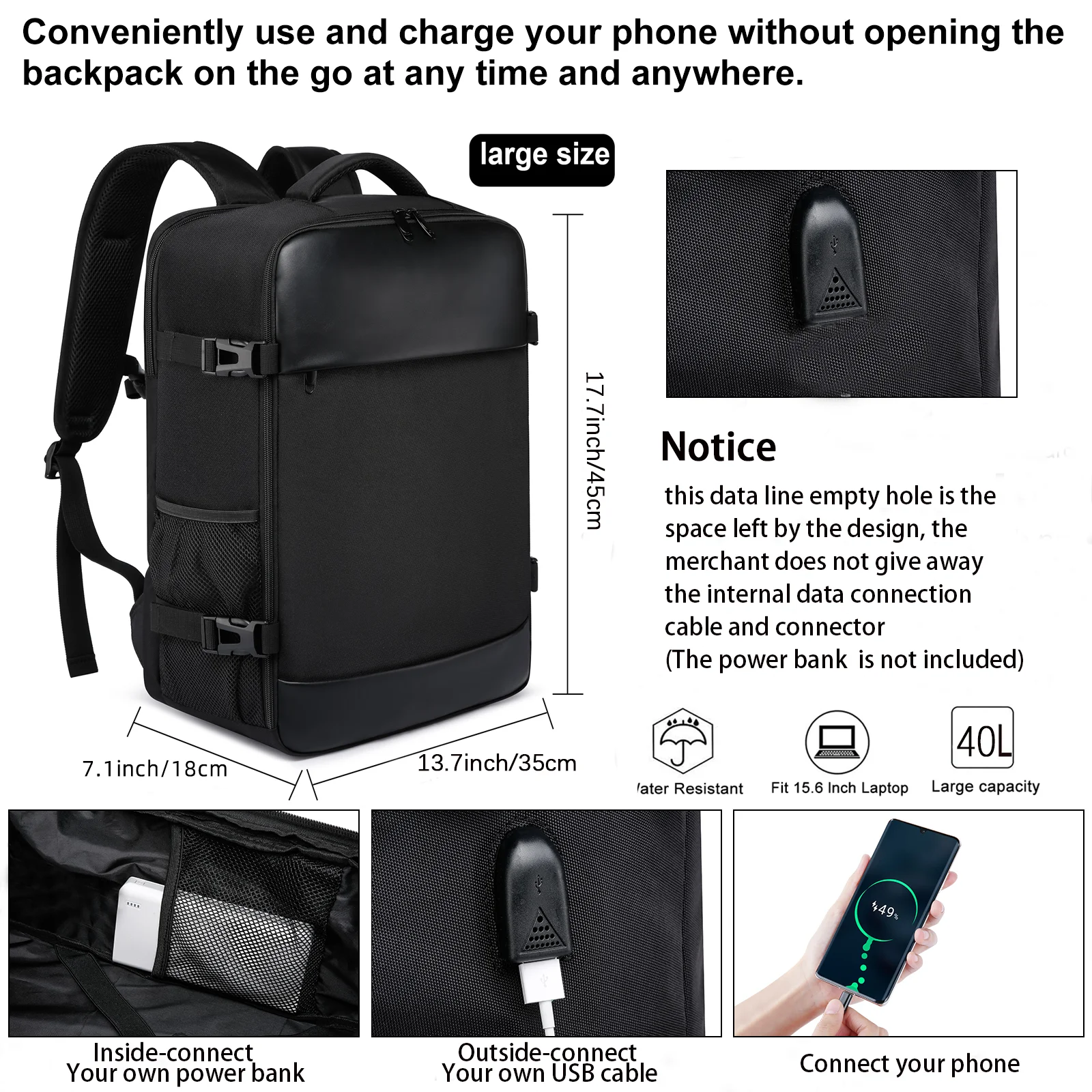
Day Hiking vs. Multi-Day Backpacking
Day hiking and multi-day backpacking require different approaches to weight distribution due to the significant differences in load weight and volume.
For day hiking (typically under 20 pounds):
– Weight can be distributed slightly higher in the pack
– The core zone may be smaller but should still contain the heaviest items
– Access becomes a higher priority with more items in top and side pockets
– Bottom zone may be minimal or non-existent in smaller packs
For multi-day backpacking (typically 25-45+ pounds):
– Stricter adherence to zone principles becomes crucial
– The bottom zone must be properly utilized for sleeping gear
– Core zone should be meticulously packed with heavy items centered
– Careful attention to lateral balance prevents fatigue over multiple days
Both scenarios benefit from the same fundamental principles, but the margin for error decreases as pack weight increases.
Technical Terrain and Specialized Activities
Activities involving technical movement or specialized equipment require adaptations to standard weight distribution principles.
For scrambling or technical terrain:
– Lower the pack’s center of gravity slightly for better stability
– Pack items more tightly to prevent shifting during dynamic movements
– Minimize external attachments that could catch on rocks or brush
– Consider a slightly smaller, more compact pack profile
For approach climbs or alpine activities:
– Position the weight slightly higher for improved visibility of foot placements
– Ensure technical gear is accessible but securely stowed
– Balance the weight of specialized equipment (ice axes, protection, etc.)
– Pack with consideration for how gear will be accessed throughout the day
Each activity demands subtle adjustments to the core principles while maintaining the fundamental goals of comfort, stability, and efficiency.
Maintaining Balance Throughout Your Journey: The Dynamic Approach
Backpack weight distribution isn’t a one-time task—it’s an ongoing process that requires attention throughout your journey. As you consume food and water, use gear, and encounter changing conditions, your pack’s balance will shift.
Adopting a dynamic approach to weight distribution means regularly making small adjustments to maintain optimal balance. This might include:
– Repositioning items after a significant water refill
– Moving frequently used items to more accessible locations as needed
– Adjusting compression as pack volume decreases
– Adapting to changing weather or terrain conditions
The most experienced backpackers develop an intuitive sense of how their pack should feel and make micro-adjustments throughout the day without even thinking about it. With practice, you’ll develop this same instinct.
Remember these key principles:
– Weight should be centered close to your back
– Heaviest items should sit at mid-back height
– Balance should be maintained from side to side
– The pack should move with you, not against you
– Comfort is the ultimate indicator of proper weight distribution
By applying these principles consistently, testing your setup before each trip, and making adjustments as needed, you’ll transform your backpacking experience through the science of balanced weight distribution. Your Summit Carry pack, properly loaded and adjusted, becomes not just something you carry, but a comfortable extension of yourself on all your adventures.
